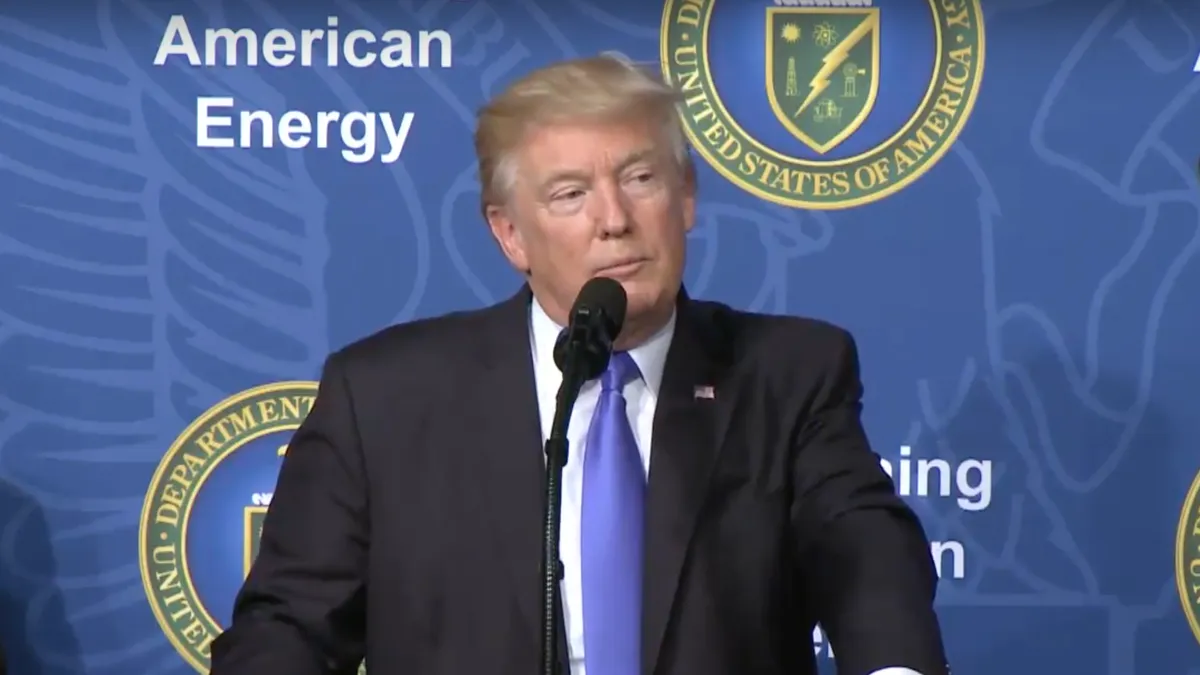Dive Brief:
- The Department of Energy's much-anticipated grid study sparked mixed reviews from different stakeholders in the power sector. The study found cheap natural gas to be the greatest driver of baseload power plant retirements — and perhaps most significantly, did not find renewables to be a threat to grid reliability, as some initially feared.
- For the most part, environmental groups did not find fault with the study's analysis, but slammed the eight recommendations outlined in the 187-page study, accusing the DOE of coming to conclusions that were unsupported by the facts within its own report.
- Trade groups were more reticent, offering cautiously optimistic statements and pledges to collaborate closely with the agency on its recommendations. Other experts said the findings add little-to-nothing to ongoing conversations about the changing power mix.
Dive Insight:
After the widely-anticipated DOE grid study was dropped late Wednesday night, responses from advocacy groups quickly flooded the email inboxes of energy reporters. Trade groups, clean energy advocates, environmental groups and other organizations all had their own takes on the grid study, with each revealing the priorities and concerns of different stakeholders.
Perhaps the biggest takeaway was that the study's findings did not turn out — as many in the sector feared in anticipation of its release — to be strongly against renewable energy. When Secretary Rick Perry Perry first ordered the DOE to undertake the study in April, he praised baseload generators and appeared to single out intermittent resources for scrutiny — instantly raising concerns among some energy stakeholders that the study was being conducted with clear-cut political aims in mind. Perry later warned the White House could seek to overrule state energy policies, such as renewables mandates, on national security grounds if reliability was found to be threatened.
The study's findings, however, did not shock anyone or go against the common thinking in the sector. The analysis was aligned with the broad industry consensus that persistently low natural gas prices and flat power demand are driving coal and nuclear plants offline — not renewable energy. Even so, the study sparked mixed reactions — and some disappointment, especially with its recommendations.
Environmental groups slammed the recommendations of the study, highlighting that they did not match up with the report's own analysis. The Natural Resources Defense Council called it a "a schizophrenic attempt to support outdated, uncompetitive, and highly polluting power plants." The Sierra Club accused the DOE of attempting to "pressure" grid operators, FERC and utilities "to bail out aging coal and nuclear plants by forcing electricity customers to pay more for their expensive electricity."
Trade groups were slower to react, with many saying they were still reviewing the study. Edison Electric Institute, the trade group for investor-owned utilities, said that while it was "still thoroughly reviewing the study, [they have] long advocated that our customers are best served by public policies that promote a balanced and diverse energy mix, which includes both traditional and renewable energy sources, and that also recognize the vital role 24/7 energy sources play in sustaining a secure, reliable, and resilient energy grid."
The Solar Energy Industries Association said they were still reviewing the study as well, but noted the important role solar plays in a "resilient grid" and urged the DOE to consider solar's value. Wind trade group American Wind Energy Association touted wind resources as vital for a resilient grid, and urged the agency to ease regulations on transmission projects to encourage more wind turbine construction.
The most interesting responses did not come from the stakeholders, but energy experts. A few highlighted that the recommendations in the report do not align with the findings of the report itself.
Clean energy research group Rocky Mountain Institute (RMI) said the study correctly identified the issues facing the power sector, but incorrectly recommended 20th century technologies to be the solution to these issues. "[The study] misses out on the opportunity to reap the benefits of 21st-century innovation and drive the U.S. grid toward a least-cost, reliable, and resilient future," RMI said in a statement. "The study recommends that the U.S. seek “energy dominance” — but it suggests that we look backward to find it."
Ari Peskoe, a senior electricity fellow at Harvard Law School, wrote in a blog post that the grid study offered nothing new. He noted the 2016 Quadrennial Energy Review already spotlighted the same issues, but with one key difference. "The QER ... aimed to ensure that regulators and market operators had the tools to ensure reliability in the face of dramatic changes that challenge many of the industry’s long-held assumption," he wrote.
In contrast, the new study merely aligned with those findings and other widely-documented conclusions in the power sector. Most notably, the study's "proposed responses are constrained by the terms of Perry’s memo," Peskoe wrote. "Rather than embracing and seeking to accelerate current trends, as the QER did, the Grid Study examines how to shoehorn old, inflexible generators into a rapidly evolving and more nimble grid."
It remains to be seen how the DOE and other federal agencies will move ahead with the recommendations of the study, but it's readily apparent that stakeholders on all sides of the debate will be watching closely.














